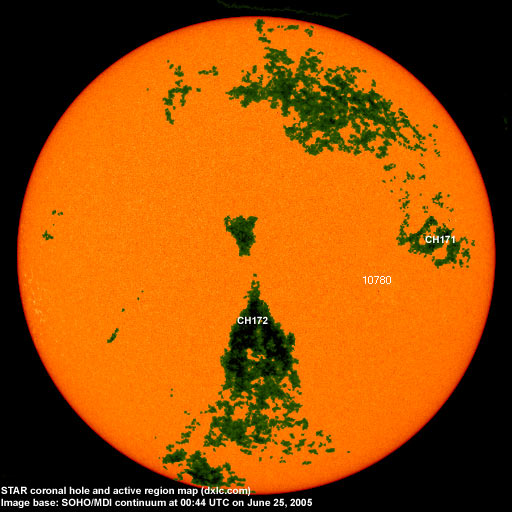

Last major update issued on June 25, 2005 at 05:40 UTC.
[Solar and
geomagnetic data - last month (updated daily)]
[Solar wind and
electron fluence charts (updated daily)]
[Solar cycles 21-23
(last update June 4, 2005)]
[Solar cycles 1-20]
[Graphical comparison
of cycles 21, 22 and 23 (last update June 4, 2005)]
[Graphical
comparison of cycles 2, 10, 13, 17, 20 and 23 (last update June 4, 2005)]
[Historical solar and
geomagnetic data charts 1954-2004 (last update February 1, 2005)]
[Archived reports
(last update June 21, 2005)]
The geomagnetic field was quiet to minor storm on June 24. Solar wind speed ranged between 453 and 557 (all day average 497) km/sec under the influence of a high speed stream from CH171.
Solar flux measured at 20h UTC on 2.8 GHz was 76.7. The planetary
A
index was 17 (STAR Ap - based on the mean of three hour interval ap
indices: 16.6).
Three hour interval K indices: 45333112 (planetary), 45333112 (Boulder).
The background x-ray flux is at the class A2 level.
At midnight there was one spotted region on the visible solar disk. The solar flare activity level was very low. No C class events were recorded during the day.
Region 10780 reemerged with a few spots.
June 22-24: No obvious fully or partly Earth directed CMEs were observed in available LASCO images.
Coronal hole
history (since late October 2002)
Compare today's report with the situation one solar rotation ago: 28
days ago 27 days ago 26
days ago
A recurrent coronal hole (CH171) in the northern hemisphere was in an Earth facing position on June 20-22. A coronal hole (CH172) in the southern hemisphere (and with a trans equatorial extension) was in an Earth facing position on June 24-25.

Processed SOHO/EIT 284 image at 01:32 UTC on June 25. The darkest areas on the solar disk are likely coronal holes.
The geomagnetic field is expected to be quiet to active on June 25 due to a high speed stream from CH171 and quiet to unsettled on June 26. A high speed stream from CH172 will likely reach Earth on June 27 and cause unsettled to active conditions that day and on June 28.
| Coronal holes (1) | Coronal mass ejections (2) | M and X class flares (3) |
1) Effects from a coronal hole could reach Earth
within the next 5 days. When the high speed stream has arrived
the color changes to green.
2) Material from a CME is likely to impact Earth within 96 hours.
3) There is a possibility of either M or X class flares within the next
48 hours.
Green: 0-20% probability, Yellow: 20-60% probability, Red: 60-100% probability.
Long distance low and medium frequency (below 2 MHz) propagation along east-west paths over high and upper middle latitudes is very poor. Propagation along long distance north-south paths is good. Trans Atlantic propagation conditions are normally monitored every night on 1470 kHz. Dominant stations tonight: Radio Cristal del Uruguay and Rafaela Argentina. Lots of stations from mainly Argentina were heard on other frequencies with audio finally popping up on 1710 kHz and Radio Dolores audible on 1480 kHz.

Compare to the previous day's image.
Data for all numbered solar regions according to the Solar Region Summary provided by NOAA/SEC. Comments are my own, as is the STAR spot count (spots observed at or inside a few hours before midnight) and data for regions not numbered by SEC or where SEC has observed no spots. SEC active region numbers in the table below and in the active region map above are the historic SEC/USAF numbers.
| Active region | Date numbered | SEC spot count |
STAR spot count |
Location at midnight | Area | Classification | Comment |
|---|---|---|---|---|---|---|---|
| 10780 | 2005.06.17 | 4 | 2 | S08W30 | 0020 | BXO | |
| Total spot count: | 4 | 2 | |||||
| SSN: | 14 | 12 | |||||
| Month | Average solar flux at Earth |
International sunspot number | Smoothed sunspot number |
|---|---|---|---|
| 2000.04 | 184.2 | 125.5 | 120.8 cycle 23 sunspot max. |
| 2000.07 | 202.3 | 170.1 | 119.8 |
| 2001.12 | 235.1 | 132.2 | 114.6 (-0.9) |
| 2004.04 | 101.2 | 39.3 | 45.5 (-1.6) |
| 2004.05 | 99.8 | 41.5 | 43.8 (-1.7) |
| 2004.06 | 97.4 | 43.2 | 41.6 (-2.2) |
| 2004.07 | 119.1 | 51.1 | 40.2 (-1.4) |
| 2004.08 | 109.6 | 40.9 | 39.2 (-1.0) |
| 2004.09 | 103.1 | 27.7 | 37.5 (-1.7) |
| 2004.10 | 105.9 | 48.0 | 35.9 (-1.6) |
| 2004.11 | 113.2 | 43.5 | 35.3 (-0.6) |
| 2004.12 | 94.5 | 17.9 | (34.8 predicted, -0.5) |
| 2005.01 | 102.2 | 31.3 | (32.8 predicted, -2.0) |
| 2005.02 | 97.2 | 29.1 | (30.4 predicted, -2.4) |
| 2005.03 | 89.9 | 24.8 | (28.8 predicted, -1.6) |
| 2005.04 | 86.0 | 24.4 | (26.9 predicted, -1.9) |
| 2005.05 | 99.3 | 42.6 | (24.3 predicted, -2.6) |
| 2005.06 | 96.1 (1) | 53.2 (2) | (22.8 predicted, -1.5) |
1) Running average based on the daily 20:00 UTC observed solar flux
value at 2800 MHz.
2) Unofficial, accumulated value based on the Boulder (NOAA/SEC)
sunspot number. The official international sunspot number is typically
30-50% lower.
This report has been prepared by Jan Alvestad. It is based partly on my own observations and analysis, and partly on data from some of these solar data sources. All time references are to the UTC day. Comments and suggestions are always welcome.
| [DX-Listeners' Club] |